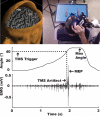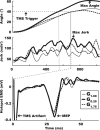Visuomotor gain distortion alters online motor performance and enhances primary motor cortex excitability in patients with stroke
- PMID: 22672345
- PMCID: PMC3752791
- DOI: 10.1111/j.1525-1403.2012.00467.x
Visuomotor gain distortion alters online motor performance and enhances primary motor cortex excitability in patients with stroke
Abstract
Objectives: Determine if ipsilesional primary motor cortex (M1) in stroke patients processes online visuomotor discordance in gain between finger movement and observed feedback in virtual reality (VR).
Materials and methods: Chronic stroke patients flexed (N= 7) or extended (N= 1) their finger with real-time feedback of a virtual hand presented in VR. Virtual finger excursion was scaled by applying a low-gain (G(0.25) ), high-gain (G(1.75) ), or veridical (G(1.00) ) scaling factor to real-time data streaming from a sensor glove. Effects of visuomotor discordance were assessed through analysis of movement kinematics (joint excursion, movement smoothness, and angular velocity) and amplitude of motor evoked potentials (MEPs) elicited with transcranial magnetic stimulation applied to ipsilesional M1. Data were analyzed with a repeated-measures analysis of variance (significance set at 0.05).
Results: G(0.25) discordance (relative to veridical) leads to significantly larger joint excursion, online visuomotor correction evidenced by decreased trajectory smoothness, and significantly facilitated agonist MEPs. This effect could not be explained by potential differences in motor drive (background electromyographic) or by possible differences related to joint angle or angular velocity, as these variables remained invariant across conditions at the time of MEP assessment. M1 was not significantly facilitated in the G(1.75) condition. MEPs recorded in an adjacent muscle that was not involved in the task were unaffected by visual feedback in either discordance condition. These data suggest that the neuromodulatory effects of visuomotor discordance on M1 were relatively selective.
Conclusions: Visuomotor discordance may be used to alter movement performance and augment M1 excitability in patients following stroke. Our data illustrate that visual feedback may be a robust way to selectively modulate M1 activity. These data may have important clinical implications for the development of future VR training protocols.
© 2012 International Neuromodulation Society.
Figures



References
-
- Lang CE, Wagner JM, Bastian AJ, Hu Q, Edwards DF, Sahrmann SA, et al. Deficits in grasp versus reach during acute hemiparesis. Experimental brain research Experimentelle Hirnforschung Experimentation cerebrale. 2005;166(1):126–36. - PubMed
-
- Lang CE, Wagner JM, Edwards DF, Sahrmann SA, Dromerick AW. Recovery of grasp versus reach in people with hemiparesis poststroke. Neurorehabilitation and neural repair. 2006;20(4):444–54. - PubMed
-
- Nakayama H, Jorgensen HS, Raaschou HO, Olson TS. Recovery of upper extremity function in stroke patients: the Copenhagen stroke study. Arch Phys Med Rehabil. 1994;75:394–8. - PubMed
-
- Olsen TS. Arm and leg paresis as outcome predictors in stroke rehabilitation. Stroke; a journal of cerebral circulation. 1990;21(2):247–51. - PubMed
Publication types
MeSH terms
Grants and funding
LinkOut - more resources
Full Text Sources
Medical

